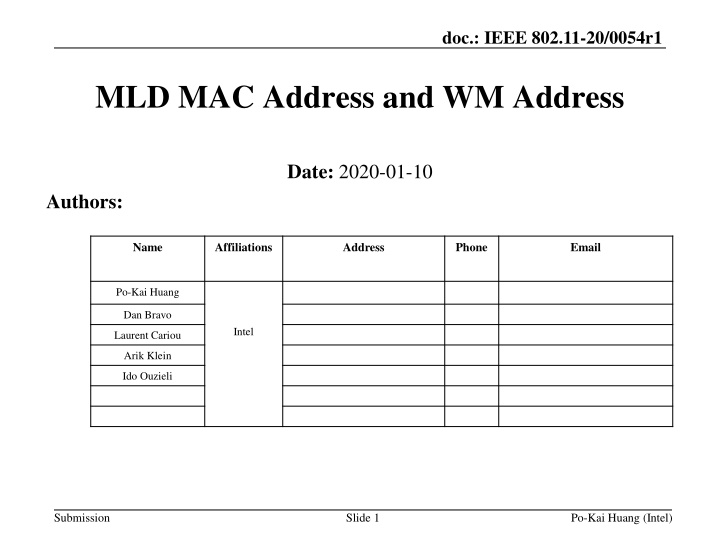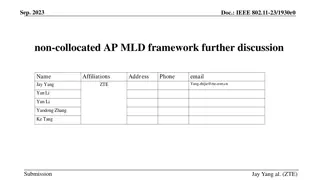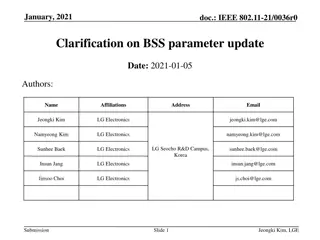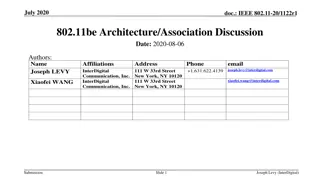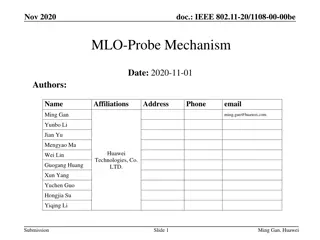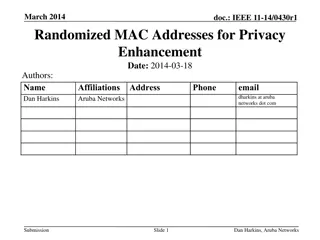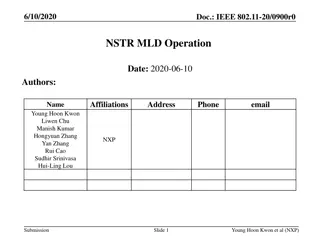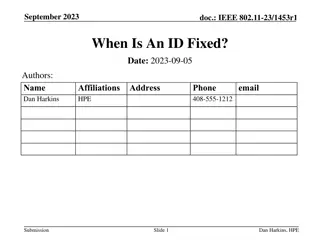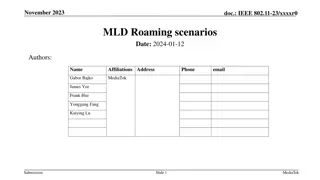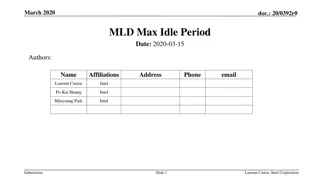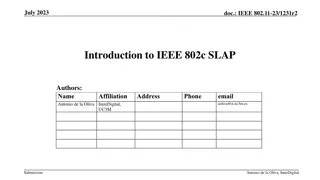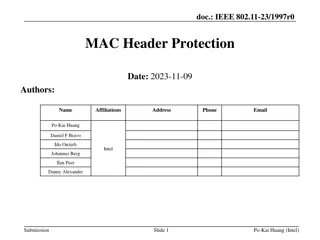IEEE 802.11-20/0054r1 MLD MAC Address and WM Address
In the document IEEE 802.11-20/0054r1, the focus is on Multi-Link Framework for MLD address identification and differentiation. It explains the usage of MLD MAC address and STA WM medium address in wireless setups. The document also addresses the need for identifying different MLDs using MAC addresses and emphasizes the importance of unique MAC addresses for affiliated APs. Symmetric operation for non-AP MLD for peer-to-peer communication simplifies implementation considerations.
Download Presentation

Please find below an Image/Link to download the presentation.
The content on the website is provided AS IS for your information and personal use only. It may not be sold, licensed, or shared on other websites without obtaining consent from the author.If you encounter any issues during the download, it is possible that the publisher has removed the file from their server.
You are allowed to download the files provided on this website for personal or commercial use, subject to the condition that they are used lawfully. All files are the property of their respective owners.
The content on the website is provided AS IS for your information and personal use only. It may not be sold, licensed, or shared on other websites without obtaining consent from the author.
E N D
Presentation Transcript
doc.: IEEE 802.11-20/0054r1 MLD MAC Address and WM Address Date: 2020-01-10 Authors: Name Affiliations Address Phone Email Po-Kai Huang Dan Bravo Intel Laurent Cariou Arik Klein Ido Ouzieli Submission Slide 1 Po-Kai Huang (Intel)
doc.: IEEE 802.11-20/0054r1 Background Multi-link framework has been proposed below with the definition of MLD address[1] a MLD has a MAC address that identifies the MLD management entity For example, the MAC address can be used in multi-link setup between a non-AP MLD and an AP MLD We provide follow up to MLD MAC address and STA WM medium address AP MLD Non-AP MLD AP1 AP1 STA1 Link 1 Response frame for multi-link setup Request frame for multi-link setup AP2 STA2 Link 2 AP3 STA3 Link 3 Non-AP STA1 Submission Slide 2 Po-Kai Huang (Intel)
doc.: IEEE 802.11-20/0054r1 MLD MAC Address and STA WM Medium Address On a high level, we think that MLD MAC address is used to identify and differentiate different MLDs STA WM MAC address is used for on the air transmission on the corresponding wireless medium MLD MAC address is used to identify different MLDs MLD STA 1 2.4 GHz STA 2 5 GHz STA 3 6 GHz STA 1/2/3 WM MAC address is used for over the air transmission on the corresponding WM The following clarification in SFD is needed A MLD has a MAC address that singly identifies the MLD management entity. Submission Slide 3 Po-Kai Huang (Intel)
doc.: IEEE 802.11-20/0054r1 AP MLD MAC Address and WM Medium Address AP MLD AP 1 2.4 GHz AP 2 5 GHz AP 3 6 GHz For AP MLD to continue to serve legacy non-HT/HT/VHT/HE STA, each affiliated AP of a AP MLD shall use different MAC address There exists ambiguity if two affiliated APs use the same MAC addresses For example, if AP1 and AP2 use the same MAC address, it is hard for legacy STA to know if AP2 is a different AP of AP1 or it is AP 1 doing channel switch For AP MLD MAC address, we do not see requirement to standardize relation with the MAC address of affiliated APs, but are open for discussion Submission Slide 4 Po-Kai Huang (Intel)
doc.: IEEE 802.11-20/0054r1 Non-AP MLD MAC Address and WM Medium Address Non-AP MLD Non-AP 1 2.4 GHz Non-AP 2 5 GHz Non-AP 3 6 GHz For non-AP MLD, if AP MLD uses different MAC addresses for affiliated STAs, it makes sense to have symmetric operation for non-AP MLD as well Non-AP MLD may serve as soft AP for peer to peer communication. Symmetric operation simplify implementation consideration Transmission from non-AP MLD to AP MLD in different link may have the same Nonce for different message if affiliated non-AP STAs have same MAC address under same PN space/PTK [3], which destroys the security property For non-AP MLD MAC address, we do not see requirement to standardize relation with the MAC address of affiliated non-APs, but are open for discussion Submission Slide 5 Po-Kai Huang (Intel)
doc.: IEEE 802.11-20/0054r1 non-AP MLD Address in Multi-link Setup Procedure For legacy association, an AP differentiates different associated non-AP STA through MAC address of non-AP STA For multi-link setup, we envision that differentiation of different non-AP MLD will require a similar identifier, and we think the MAC address of non-AP MLD can serve similar purpose An identifier with smaller size may lead to identifier collision and confusion of setup result Without identifier, differentiation of different non-AP MLD has to be based on all the configuration details of non-AP MLD, and figuring out difference like resetup with different configuration is difficult Knowing non-AP MLD MAC address after setup is useful for following negotiations like security [3] and BA [4] Proposal: non-AP MLD MAC address is indicated during the multi-link setup procedure Submission Slide 6 Po-Kai Huang (Intel)
doc.: IEEE 802.11-20/0054r1 Example AP MLD AP MLD Easily understand as same non- AP MLD with configuration change during resetup AP1 AP2 AP3 AP1 AP2 AP3 Multi-link Setup Request with non- AP MLD 1 address Resend Multi-link Setup Request with non-AP MLD 1 address Multi-link Setup Response Multi-link Setup Response Non-AP 1.1 Non-AP 1.2 Non-AP 1.3 Non-AP 1.2 Non-AP 1.3 Easily differentiate multi-link setup with different non-AP MLD Non-AP MLD 1 Non-AP MLD 1 AP MLD AP1 AP2 AP3 Multi-link Setup Request with non- AP MLD 2 address Multi-link Setup Response Non-AP 2.1 Non-AP 2.2 Non-AP 2.3 Non-AP MLD 2 Submission Slide 7 Po-Kai Huang (Intel)
doc.: IEEE 802.11-20/0054r1 AP MLD Address in Multi-link Setup Procedure For legacy association, the MAC address of the associated AP is known before association. For multi-link setup, it is TBD if AP MLD discovery can provide the MAC address of AP MLD If AP MLD address is not known before multi-link setup, then having AP MLD address in multi-link setup procedure is useful for following negotiations like security [3] and BA [4] If AP MLD address is known before multi-link setup, then having AP MLD address in multi- link setup procedure is useful to confirm the destined MLD for setup and avoid weird corner case Proposal: AP MLD MAC address is indicated during the multi-link setup procedure Submission Slide 8 Po-Kai Huang (Intel)
doc.: IEEE 802.11-20/0054r1 Example If AP MLD address is not available before multi-link setup, AP MLD AP1 AP2 AP3 Multi-link setup request Multi-link setup response Both AP MLD and non-AP MLD knows the MLD address of each other after setup, which is useful for following negotiations like security [3] and BA [4] with non-AP MLD address with AP MLD address Non-AP 1.1 Non-AP 1.2 Non-AP 1.3 Non- AP MLD 1 Submission Slide 9 Po-Kai Huang (Intel)
doc.: IEEE 802.11-20/0054r1 Example If AP MLD address is available before multi-link setup, using AP MLD address in multi-link setup request rather than AP1 address in RA to identify AP MLD avoids the possible ambiguity when configuration changes AP MLD 1 AP MLD 2 AP MLD 2 AP1 AP2 AP3 AP4 AP5 AP1 AP4 AP5 Multi-link setup response deny the setup due to different understanding Multi-link setup request with non-AP MLD address Configuration changes and AP MLD 1 address AP MLD 1 AP MLD 2 Non-AP 1.1 Non-AP 1.2 Non-AP 1.3 AP2 AP3 AP1 AP4 AP5 Non- AP MLD 1 Submission Slide 10 Po-Kai Huang (Intel)
doc.: IEEE 802.11-20/0054r1 Need of MLD address in SA/DA The definition of SA and DA in the spec is as follows: The source address (SA) parameter specifies an individual MAC sublayer address of the sublayer entity from which the MSDU is being transferred. The destination address (DA) parameter specifies either an individual or a group MAC sublayer entity address. Given that in multi-link, a MLD only has one data service interface to the LLC, the address used in the SA/DA shall use the MLD address to identify the source MLD and destination MLD. Submission Slide 11 Po-Kai Huang (Intel)
doc.: IEEE 802.11-20/0054r1 Conclusion We think that different affiliated APs of a non-MLD shall have different MAC addresses. We think that if different affiliated APs of a non-MLD shall have different MAC addresses, then different affiliated non-AP STAs of a non-AP MLD shall have different MAC addresses. We propose to indicate AP MLD MAC address and non-AP MLD MAC address during the multi-link setup procedure Clearly identify the MLD for setup and avoids ambiguity, which aligns with the agreed motion text in SFD For example, the MAC address can be used in multi-link setup between a non-AP MLD and an AP MLD Useful for following negotiations like security [3] and BA [4] Useful for filling in SA/DA Submission Slide 12 Po-Kai Huang (Intel)
doc.: IEEE 802.11-20/0054r1 Straw Poll #1 Do you agree to revise the 11be SFD as follows: A MLD has a MAC address that singly identifies the MLD management entity. Submission Slide 13 Po-Kai Huang (Intel)
doc.: IEEE 802.11-20/0054r1 Straw Poll #2 Do you support to indicate AP MLD MAC address and non-AP MLD MAC address during the multi-link setup procedure? Submission Slide 14 Po-Kai Huang (Intel)
doc.: IEEE 802.11-20/0054r1 Straw Poll #3 Do you support that if different affiliated APs of an AP MLD have different MAC addresses, then different affiliated non-AP STAs of a non-AP MLD have different MAC addresses? Submission Slide 15 Po-Kai Huang (Intel)
doc.: IEEE 802.11-20/0054r1 Reference [1] 19/0822r9 Extremely efficient multi-band operation [2] 19/0773r8 Multi-link operation framework [3] 19/1822r2 Multi-link security consideration [4] 20/0053r0 Multi-link BA Submission Slide 16 Po-Kai Huang (Intel)
